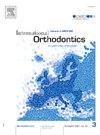Comprehensive qualitative and quantitative assessment of the most suitable levels for maxillary and mandibular miniscrew insertion sites: A cross-sectional comparative study
IF 1.9
Q2 DENTISTRY, ORAL SURGERY & MEDICINE
引用次数: 0
Abstract
Introduction
To analyse the quality and quantity of inter-radicular buccal and palatal cortical bone in the maxillary and mandibular regions at the most recommended levels for miniscrew insertion sites in both sexes.
Methods
This retrospective, cross-sectional comparative study utilized Cone Beam Computed Tomography (CBCT) scans from 60 adult patients meeting the selection criteria. The analysis focused on Cortical Bone Thickness (CBT), Inter-radicular Space (IRS), and Relative Cortical Bone Density (RCBD) at eleven maxillary and six mandibular miniscrew insertion sites, measured at 4, 6, and 8 mm from the cemento-enamel junction.
Results
CBT on the maxillary buccal side ranged from 0.85 ± 0.13 to 1.32 ± 0.14 mm, with all palatal sites measuring at least 1 mm. Palatal areas showed greater IRS than buccal sites, with no significant sex differences. RCBD indicated significant differences at 6 mm (P = 0.004) and 8 mm (P = 0.008), where females had higher density than males. In the mandible, CBT ranged from 1.20 ± 0.22 to 2.63 ± 0.36 mm, with the lowest IRS in the canine-premolar region at 4 mm and the highest in the molar area at 8 mm. High densities were observed across levels without sex preference.
Conclusion
It is advisable to position orthodontic miniscrews as far as possible in the attached gingiva of the maxillary buccal and mandibular canine-premolar regions. For maxillary palatal miniscrews, preferred insertion depths are 6 mm in the premolar and 4 mm in the molar regions, and predrilling at 6 mm is recommended in the mandibular molar region. Limited sex differences were noted.
综合定性和定量评估最适合水平的上颌和下颌微型植入点:横断面比较研究
目的:分析男女上颌和下颌骨根间、颊部和腭部皮质骨在最推荐水平下的质量和数量。方法采用锥束计算机断层扫描(CBCT)对60例符合选择标准的成人患者进行回顾性、横断面比较研究。分析的重点是上颌11个和下颌骨6个微钉插入点的皮质骨厚度(CBT)、根间间隙(IRS)和相对皮质骨密度(RCBD),测量距离牙骨质-牙釉质交界处4、6和8 mm。结果上颌颊侧scbt范围为0.85±0.13 ~ 1.32±0.14 mm,所有腭部均≥1 mm。腭区IRS高于颊区,性别差异不显著。RCBD在6 mm (P = 0.004)和8 mm (P = 0.008)处差异显著,雌性密度高于雄性。下颌骨的CBT范围为1.20±0.22 ~ 2.63±0.36 mm,其中犬前磨牙区IRS最小,为4 mm,磨牙区IRS最高,为8 mm。在没有性别偏好的水平上观察到高密度。结论正畸微钉尽量放置在上颌、颊、下颌犬-前磨牙区附着龈处为宜。对于上颌腭微型螺钉,首选的插入深度为前磨牙6mm和磨牙4mm,建议在下颌磨牙区域预钻6mm。注意到有限的性别差异。
本文章由计算机程序翻译,如有差异,请以英文原文为准。
求助全文
约1分钟内获得全文
求助全文
来源期刊

International Orthodontics
DENTISTRY, ORAL SURGERY & MEDICINE-
CiteScore
2.50
自引率
13.30%
发文量
71
审稿时长
26 days
期刊介绍:
Une revue de référence dans le domaine de orthodontie et des disciplines frontières Your reference in dentofacial orthopedics International Orthodontics adresse aux orthodontistes, aux dentistes, aux stomatologistes, aux chirurgiens maxillo-faciaux et aux plasticiens de la face, ainsi quà leurs assistant(e)s. International Orthodontics is addressed to orthodontists, dentists, stomatologists, maxillofacial surgeons and facial plastic surgeons, as well as their assistants.
 求助内容:
求助内容: 应助结果提醒方式:
应助结果提醒方式:


